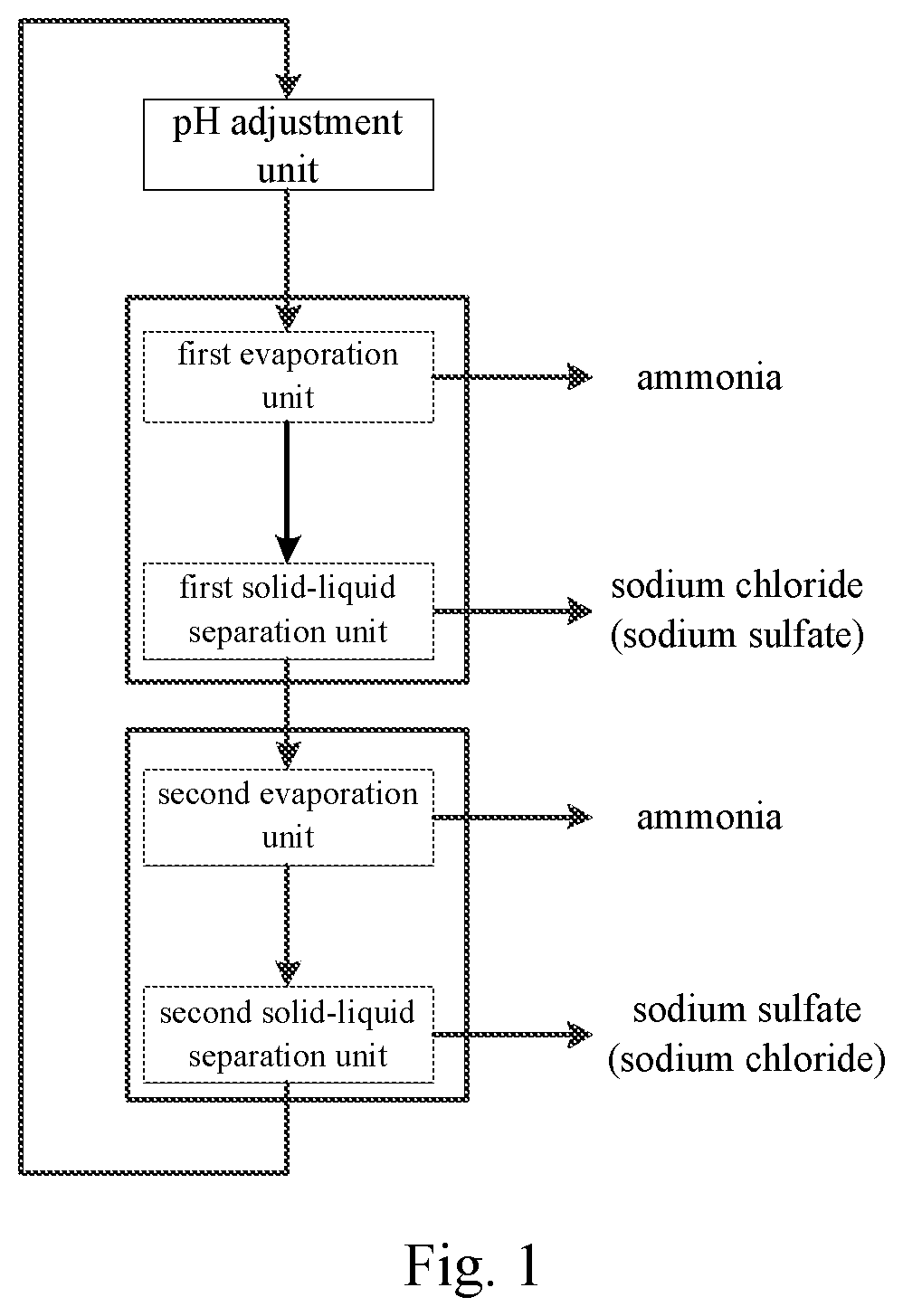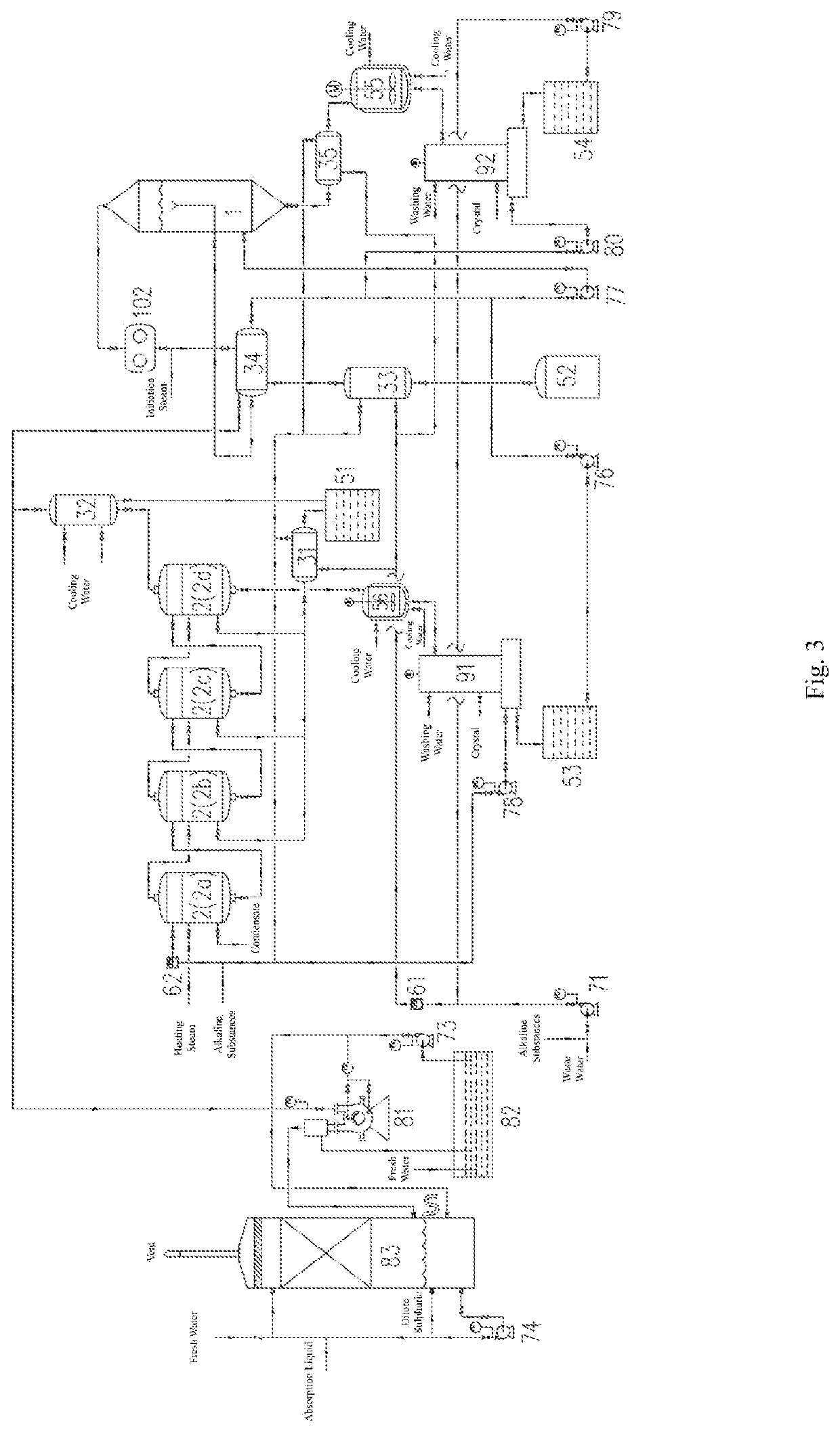Apparatus and method for treating waste water containing ammonium salts
a technology of ammonium salt and apparatus, which is applied in the field of apparatus and methods for treating waste water containing ammonium salt, can solve the problems of high treatment cost, increased waste water treatment cost, and difficulty in treating ammonium mixed salts, and achieves the effect of reducing the cost of waste water treatmen
- Summary
- Abstract
- Description
- Claims
- Application Information
AI Technical Summary
Benefits of technology
Problems solved by technology
Method used
Image
Examples
embodiment 1
[0237]As shown in FIG. 2, waste water containing ammonium salts (containing 80 g / L NaCl, 81 g / L Na2SO4, 48 g / L NH4Cl, and 49.4 g / L (NH4)2SO4, pH=6.2) is fed at 5 m3 / h feed rate and mixed with the second mother liquid to obtain waste water to be treated (the molar ratio of SO42− to Cl− is 1:3.7487), the waste water to be treated is loaded into the main pipeline of the first heat exchange device 31, the third heat exchange device 33, and the fifth heat exchange device 35 (all of them are titanium alloy plate-type heat exchangers), the pH of the mixture is monitored with the first pH measuring device 61 (a pH meter) (the measured value is 9.2), a part of the waste water to be treated (3 m3 / h) is fed by means of the first circulation pump 71 into the first heat exchange device 31 to perform the first heat exchange with the condensate of first ammonia-containing vapor so that the temperature of the waste water to be treated is increased to 99° C., another part of the waste water to be tr...
embodiment 2
[0243]The waste water containing ammonium salts is treated with the method described in the embodiment 1, but: waste water containing ammonium salts that contains 65 g / L NaCl, 130 g / L Na2SO4, 12 g / L NH4Cl and 24.4 g / L (NH4)2SO4 with pH=6.5 is treated, and the molar ratio of SO42− to Cl− contained in the obtained waste water to be treated is 1:2.291. A part of the waste water to be treated (4 m3 / h) flows through the first heat exchange device 31 for the first heat exchange, so that the temperature of the waste water to be treated is increased to 94° C., another part of the waste water to be treated (1 m3 / h) flows through the third heat exchange device 33 for the first heat exchange, so that the temperature of the waste water to be treated is increased to 99° C., and the remaining part of the waste water to be treated flows through the fifth heat exchange device 35 for the first heat exchange, so that the temperature of the waste water to be treated is increased to 99° C.; then the pa...
embodiment 3
[0246]The waste water containing ammonium salts is treated with the method described in the embodiment 1, but: waste water containing ammonium salts that contains 168 g / L NaCl, 35 g / L Na2SO4, 40 g / L NH4Cl and 8.47 g / L (NH4)2SO4 with pH=6.6 is treated, and the molar ratio of SO42− to Cl− contained in the obtained waste water to be treated is 1:9.3964. The temperature of the waste water to be treated after the heat exchange in the first heat exchange device 31 is 99° C., the temperature of the waste water to be treated after the heat exchange in the third heat exchange device 33 is 99° C., the temperature of the waste water to be treated after the heat exchange in the fifth heat exchange device 35 is 105° C., and the temperature of the waste water to be treated after the heat exchange in the second heat exchange device 32 is 112° C. In the first evaporation device 2, the evaporation temperature is 105° C., the pressure is −7.02 kPa, and the amount of evaporation is 2.36 m3 / h. In the s...
PUM
| Property | Measurement | Unit |
|---|---|---|
| temperature | aaaaa | aaaaa |
| pressure | aaaaa | aaaaa |
| temperature | aaaaa | aaaaa |
Abstract
Description
Claims
Application Information
 Login to View More
Login to View More - R&D
- Intellectual Property
- Life Sciences
- Materials
- Tech Scout
- Unparalleled Data Quality
- Higher Quality Content
- 60% Fewer Hallucinations
Browse by: Latest US Patents, China's latest patents, Technical Efficacy Thesaurus, Application Domain, Technology Topic, Popular Technical Reports.
© 2025 PatSnap. All rights reserved.Legal|Privacy policy|Modern Slavery Act Transparency Statement|Sitemap|About US| Contact US: help@patsnap.com



